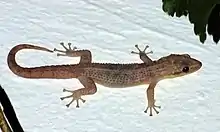| Belize leaf-toed gecko | |
|---|---|
 | |
| Phyllodactylus insularis in Turneffe Flats, Belize | |
| Scientific classification | |
| Domain: | Eukaryota |
| Kingdom: | Animalia |
| Phylum: | Chordata |
| Class: | Reptilia |
| Order: | Squamata |
| Family: | Phyllodactylidae |
| Genus: | Phyllodactylus |
| Species: | P. insularis |
| Binomial name | |
| Phyllodactylus insularis Dixon, 1960 | |
The Belize leaf-toed gecko[2] (Phyllodactylus insularis) is a species of gecko native to Belize. It is a small, pale, large headed gecko[3] only found on small islands off Belize's coast[4] and was first described by James R. Dixon in 1960.[5] This species is currently classified as "vulnerable" by the IUCN Red List.[1]
Description
The Belize leaf-toed gecko is a small, pale, large-headed gecko.[3] It is nocturnal and emerges from under barks and limbs to feed on insects and other arthropods. Like other geckos it has adhesive friction pads on the toes of each foot.[6] The gecko emits a sounds similar to a high pitched squeak or click.[6]
Habitat
The gecko lives in trees and can be found in littoral forests on small islands.[7] It is endemic to lowland Maya forests.[8] Sub adults are exclusively found under surface objects while adults are found solely on palm trunks[9]
Distribution
The Belize leaf-toed gecko has been recorded on Half Moon Caye, Long Caye, Twin Cayes, Glover's Reef, Crawl Caye, False Caye, Lagoon Caye, Peter Douglas Caye, Ambergris Caye and West Snake Caye off the coast of Belize.[4]
Elevation
Reproduction
They are oviparous and typically lay 1 or 2 eggs in a clutch[10]
Predation
Phyllodactus insularis is known to be preyed upon by rats.[3]
Threats
The IUCN Red List reports that habitat destruction caused by tourism development is a threat to this species. It is also threatened by sea level rise and storm surge.[1]
See also
References
- 1 2 3 Townsend, J.H.; Walker, P. (2014). "Phyllodactylus insularis". IUCN Red List of Threatened Species. 2014: e.T203074A2759895. doi:10.2305/IUCN.UK.2014-1.RLTS.T203074A2759895.en. Retrieved 20 November 2021.
- ↑ Phyllodactylus insularis at the Reptarium.cz Reptile Database. Accessed 24 October 2017.
- 1 2 3 Meerman, J. C. (1996). "Half Moon Caye Terrestrial Survey Results and Management Implications" (PDF). Biological Diversity in Belize. Retrieved October 11, 2017.
- 1 2 3 Köhler, Gunther (2003). Reptiles of Central America (English ed.). Offenbach, Germany: Herpeton. ISBN 978-3936180022. OCLC 52843681.
- ↑ Dixon, James (1960). "The discovery of Phyllodactylus tuberculosus (Reptilia: Sauna) in Central America, the resurrection of P. xanti, and description of a new gecko from British Honduras". Herpetologica. 16 (1): 1–11. JSTOR 3890311.
- 1 2 McKeon, C. S.; Feller, I. C. (2004). "The Supratidal Fauna of Twin Cays, Belize" (PDF). Smithsonian Libraries. Retrieved October 1, 2017.
- 1 2 Wilson, L. D.; Townsend, J. H.; Johnson, J. D., eds. (2010). Conservation of Mesoamerican Amphibians and Reptiles (1 ed.). Eagle Mountain, Utah: Eagle Mountain Publishing. ISBN 9780972015448.
- ↑ Radachowsky, Jeremy (2002). "Edemism in the Maya Forest" (PDF). The Gaps Guide. Retrieved October 12, 2017.
- ↑ Julian C. Lee (1996). The Amphibians and Reptiles of the Yucatan Peninsula. Ithaca, New York: Cornell University Press. pp. xii + 500 pp. + 41 color plates. Retrieved 2017-10-14.
{{cite book}}:|website=ignored (help) - ↑ Bartlett, Richard D.; Bartlett, Patricia P. (1995). Geckos: Everything about Selection, Care, Nutrition, Diseases, Breeding, and Behavior. Barron's Educational Series. p. 43. ISBN 9780812090826.
